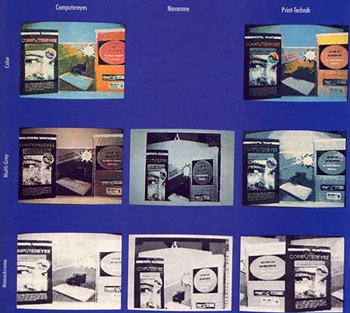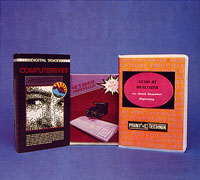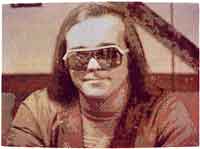

ANTIC VOL. 6, NO. 4 / AUGUST 1987 / PAGE 42
It never rains, but it pours.
For a long time, if you wanted a video digitizer for your ST computer you were limited to the HippoVision device and luck. Then, out of the blue, within the course of one month Antic's offices were deluged with three ST video digitizers: Color Computereyes, Print-Technik Realtizer, and the Navarone Video Digitizer.
For a while, it became downright dangerous for any unwary employee to venture up onto the editorial floor of Antic. If they were caught, they were forcibly digitized. We digitized anything and everything, and became well versed with the three different units. We quickly picked favorites, and depending on the job, chose between two of the three.
Each video digitizer has its own unique setup, software, and eventual output. However, we found that all three could capture and display an image in either eight or sixteen grey shades on the SF color system, and also capture and display a high-res image on the ST monochrome system. Two of the video digitizers can also capture their images in color. Keeping this in mind, we decided to digitize a single scene with all three products, in each different way of digitizing the scene, and then photograph the results.
 Take a look at Figure 1. This figure has a collection of photographs arranged in three rows and three columns. Across the top, the columns identify the output of Computereyes, then Navarone, and Print-Technik on the right. From top to bottom, the rows identify the color, multi-grey, and monochrome output pictures. Notice there is no picture for Navarone color, as it doesn't support color. For our scene we picked a still life consisting of the three boxes the video digitizers came in. They were surprisingly colorful, and besides, now you know what the box looks like when you go out to buy a digitizer. We used an RCA color video camera, mounted on a tripod, and lit the setup with a 60 watt incandescent light bulb from two feet away.
Take a look at Figure 1. This figure has a collection of photographs arranged in three rows and three columns. Across the top, the columns identify the output of Computereyes, then Navarone, and Print-Technik on the right. From top to bottom, the rows identify the color, multi-grey, and monochrome output pictures. Notice there is no picture for Navarone color, as it doesn't support color. For our scene we picked a still life consisting of the three boxes the video digitizers came in. They were surprisingly colorful, and besides, now you know what the box looks like when you go out to buy a digitizer. We used an RCA color video camera, mounted on a tripod, and lit the setup with a 60 watt incandescent light bulb from two feet away.
Examine Figure 2 . This is a standard color photograph of the boxes, so you'll have a point of reference. Take a moment and examine each image carefully. If you have sharp eyes you've probably picked out already that the Navarone monochrome picture seems to be split in half. Two of the digitizers, Navarone and PrintTechnik, had trouble saving their pictures to disk in DEGAS format. We were able to use Disk Doctor, Antic Software's disk-editing program, and repair the Print-Technik file SO DEGAS could display it, hut the other file was in a strange format, and we could not repair it without writing a small repairing program, so we chose not to. When we load the image in, it gets displaced, and that results in the picture appearing to be cut in half.
. This is a standard color photograph of the boxes, so you'll have a point of reference. Take a moment and examine each image carefully. If you have sharp eyes you've probably picked out already that the Navarone monochrome picture seems to be split in half. Two of the digitizers, Navarone and PrintTechnik, had trouble saving their pictures to disk in DEGAS format. We were able to use Disk Doctor, Antic Software's disk-editing program, and repair the Print-Technik file SO DEGAS could display it, hut the other file was in a strange format, and we could not repair it without writing a small repairing program, so we chose not to. When we load the image in, it gets displaced, and that results in the picture appearing to be cut in half.
Now look at Figure 3 . As contrast, this is a Computereyes multi-grey image of yours truly. Notice that it's not exactly pure grey, because the ST can only display eight levels of luminance, so the digitizer inserts colors "in between," by bumping up a single color register. Computereyes defaults to a rose color. The two other video digitizers only display up to eight distinct grey shades spread evenly over the sixteen-color palette.
. As contrast, this is a Computereyes multi-grey image of yours truly. Notice that it's not exactly pure grey, because the ST can only display eight levels of luminance, so the digitizer inserts colors "in between," by bumping up a single color register. Computereyes defaults to a rose color. The two other video digitizers only display up to eight distinct grey shades spread evenly over the sixteen-color palette.
When we digitized our first image, we felt waves of nostalgia wash over us. Yes, this seems to be the Hippo Video Digitizer, repackaged and with new software. Taken in that light, the software is light years ahead of where it was. The images are sharp, and offer up to eight grey scales on the color screen, and dithered images on monochrome. However, the captured image is still much smaller than the display screen on the ST Also, notice in Figure 1 that although the camera wasn't moved, the Navaronc seemed to capture much more at the top and cut off the bottom of the normal picture. It also seems to have squeezed the pictures horizontally. We worked trying to get rid of the vertical strip of noise present on the right side of each image. Playing with the small trimmer knob either locked up the SI, or devastated the image with noise. In two-color mode the Navarone can capture and display images very quickly, on the order of four or five images a second. Normally, for multi-grey, it takes about six seconds to capture a full image.
It's fairly fast, requiring about six seconds for a fast scan or 12 seconds for a slow scan picture. We didn't see much difference between the two. Color Computereyes will digitize an image from a color video source, meaning you can just plug your color video camera in and start digitizing. We found it useful to set the White Balance between each color image we captured. Computereyes can capture respectable color images, but you sometimes have to work for them. Every once in a while, we could capture an image that was remarkable in its color reproduction and clarity, but more often we wound up using the color adjusting controls available in the software.
Both color digitizers offer the means in software to adjust the color palette, contrast, and brightness of the picture. For example, using a slider-type control, you may vary the amount of red, green, or blue in the finished picture, much like playing with the palette in a typical ST drawing program. This can often make a dramatic difference in the final output of your picture. The color registers for the demonstration shots were left untouched, to show the response available to the typical user.
To do this, they supply three sheets of colored acetate—one red, one green, and one blue. Print-Technik's software is menu based; to get a color image you first hold the red plastic in front of the camera lens, then click on the RED option under DIGITIZE. Then hold up the green plastic and click on GREEN, then hold up the blue plastic and take the blue image Print-Technik will then take the red, green and blue images, and figure out where the proper colors should go. It's a somewhat roundabout way, but it works. Well, most of the time. We found with this one, as with Cornputereyes, sometimes the images popping up were stunning, but for most we had to tweak the colors or contrast around a little bit. Print-Technik, at least, worked best when the images had bright, bold shades of red, green and blue. Neither one of the color digitizers handled yellow very well.
Black and white images were easier to capture, requiring you only to click on the Digitize selection from a drop-down menu. Print-Technik will also digitize images in monochrome. As a matter of fact, some of the monochrome pictures are as good, if not better, than the multi-grey scale images we captured.
A video digitizer is an interesting toy-but it's a toy that you can make into a useful peripheral for your computer. Even if you're a fine artist who's adept with a mouse, it's still extremely difficult to create a photo-realistic piece of artwork with a standard ST paint program. However, with a good video digitizer, you can grab a real object or scene, then manipulate it with a good paint or drawing program to produce stunning computer artwork.
Now, if you'll just sit still for six seconds...
COLOR COMPUTEREYES
Digital Vision
66 Eastern Avenue
Dedham, MA 02026
(617) 329-5400
$249.95
PRINT-TECHNIK REALTIZER
MichTron
576 South Telegraph
Pontiac, MI 48053
(313) 334-5700
$199.95
NAVARONE ST VIDEO DIGITIZER
Navarone Industries
21109 Longway Road, Suite C
Sonora, CA 95370
(209) 533-8349
$139.95